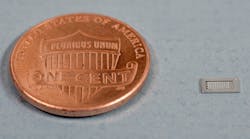Cooled With Water Droplets, Amplifiers Emit Powerful Signals
Lockheed Martin has built an experimental cooling system that sprays tiny drops of water on the bottom of microchips, dissipating heat that hurts performance.
In laboratory tests, the cold plate helped boost RF power amplifier output six times higher than chips cooled with traditional heat sinks. The technology was designed to remove heat from the thousands of power amplifiers contained in anything from radars to military communications systems.
Though the cold plate was designed to be general-purpose, Lockheed Martin has targeted the project at gallium nitride power amplifiers, which are slowly taking over electronic warfare and other defense applications. Operating at lower temperature could make these systems not only more powerful but also more efficient.
“Right now, we’re limited in the power we can put into microchips,” said John Ditri, the project’s principal researcher, in a statement. “If you can manage the heat, you can use fewer chips and that means using less material, which results in cost savings as well as reduced system size and weight. If you manage the heat and use the same number of chips, you’ll get even greater performance.”
Lockheed Martin said that recent experiments showed that the liquid cooling system vastly improved the thermal resistance of GaN monolithic microwave integrated circuits (MMICs). The company measured resistance four times higher than chips cooled with conventional, dry heat sinks.
As power amplifiers have grown more powerful, the microchips inside them have become smaller and more susceptible to heat build-up. That heat can impact performance and even raise the risk of failure. But the new cold plate dissipated 1,000 watts per square centimeter heat flex on the die. And in several local hot spots, it removed around 30,000 watts per square centimeter.
The most common way to remove heat from electronics is using fans or materials like copper that divert heat from the chip. The problem is that these heat sinks get larger as power amplifiers become more powerful, adding size and weight to the system.
But liquid cooling can happen closer to the chip, making them smaller and easier to integrate with designs practically. Lockheed Martin's cold plate was designed with that problem in mind. It measures only 250 µm thick, 5 mm long, and 2.5 mm wide.
The cold plate was developed as part of the Interchip/Intrachip Enhanced Cooling (ICECool) program run by the Defense Advanced Research Projects Agency , or DARPA. The program aims to bring liquid cooling right up against chips, sending water through channels or pores etched into the gallium nitride.
For Lockheed Martin, the long-term goal is “to see the ICECool program transition to something that will help the warfighter," said Denise Luppa, a program manager at Lockheed Martin, in a blog post. "I think we’re getting close to that.”
Going forward, Lockheed Martin will create a prototype antenna with the new cooling system. While the defense contractor has focused GaN chips for now, the cold plate could also be used with gallium-arsenide and GaN-on-diamond wafers.
